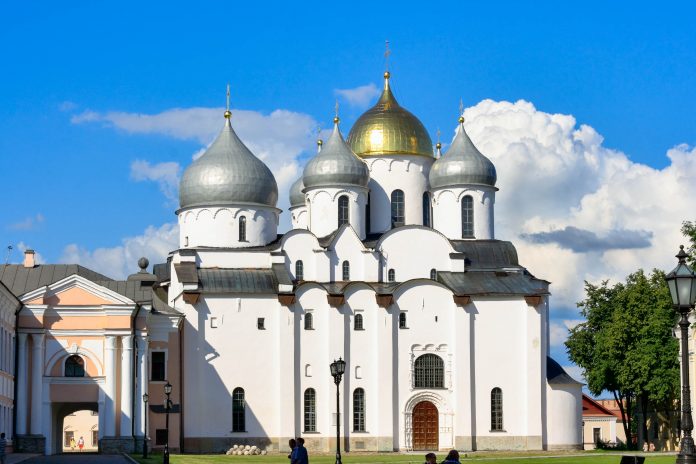Die Sophien-Kathedrale in Nowgorod ist der zweitälteste Sakralbau der Russisch-Orthodoxen Kirche und beherbergt die weltberühmte Bronze-Tür von Płock.
Die Sophien-Kathedrale in der russischen Stadt Nowgorod ist nach der gleichnamigen Kathedrale in Kiew der zweitälteste Sakralbau der Russisch-Orthodoxen Kirche und Sitz des Erzbistums Nowgorod im Nowgoroder Kreml. 1992 wurde sie mit der Altstadt von Weliki Nowgorod zum Weltkulturerbe der UNESCO erklärt. Auch auf unserer Liste der Top 10 Sehenswürdigkeiten von Russland ist sie vertreten.
Inhaltsverzeichnis
Errichtung der Sophien-Kathedrale in Nowgorod
Die Sophien-Kathedrale in Nowgorod wurde um 1050 von Vladimir von Nowgorod anstelle einer hölzernen Kirche erbaut und von Bischof Luka Zhidiata geweiht. Sie ist das älteste Kirchengebäude in Russland, das noch genutzt wird. Die Sophien-Kathedrale ist nicht einer Heiligen namens Sophia gewidmet, sondern – ähnlich der Hagia Sophia in Istanbul – der allumfassenden Weisheit Gottes.
Vom 12. bis zum 15. Jahrhundert war die Sophien-Kathedrale das geistliche und kulturelle Zentrum der damaligen Republik Nowgorod und die Nowgorodaner waren unglaublich stolz auf ihre prachtvolle Kathedrale der Heiligen Weisheit. Ein Sprichwort sagte: „Wir haben keine Prinzen, wir haben nur Gott, die Wahrheit und die Heilige Weisheit.“
Vladimir von Nowgorod selbst war der erste, der in „seiner“ Kirche begraben wurde. Neben ihm fanden bis 1912 noch 47 andere Prominente Nowgorods, darunter 32 Bischöfe, in der Sophien-Kathedrale ihre letzte Ruhestätte.
Einzigartige Architektur der Sophien-Kathedrale
Die steinerne Sophien-Kathedrale erstrahlt in leuchtendem Weiß, das ihre fünf silbernen und die 38m hohe goldene Kuppel so richtig zur Geltung bringt. Die strenge Architektur wich stark von den damaligen griechisch angelehnten Kirchenbauten ab.
Im Gegensatz zu ihrem breit angelegten Grundriss und den vielen Türmen strebt die Sophien-Kathedrale eher schlank himmelwärts. Der höchste Turm führt zu einer Galerie, in der im Mittelalter eine wertvolle Bibliothek untergebracht war, die Yaroslaw der Weise etabliert hat. Als sie 1859 nach St. Petersburg verlegt wurde, umfasste sie 1.500 Bände, einige davon über 500 Jahre alt. Erzbischof Nikolai L’vovich Tserpitskii hat aus alter Tradition wieder eine Bibliothek eingerichtet, die mittlerweile über 5.000 Bände enthält.
Die Malereien im Innenraum der Kirche aus dem frühen 12. Jahrhundert wurden Mitte des 19. Jahrhunderts restauriert. Einer der von Erzbischof Leonid im 16. Jahrhundert angebrachten Kronleuchter hat die Jahre bis heute überdauert.
Die älteste Ikone in der Sophien-Kathedrale ist die „Muttergottes vom Zeichen“ aus dem Jahr 1169, die Nowgorod einst vor einem Angriff der Suzdalen rettete. Sie ist an der Ikonenwand zu finden. Ebenso befindet sich dort die weltberühmte Bronze-Tür von Płock, die durch ihre 26 Platten mit atemberaubend detaillierten Figürchen beeindruckt.
Die Bronze-Tür aus Płock
Die Mitte des 12. Jahrhunderts in Magdeburg kunstvoll gegossene Bronze-Tür war ursprünglich für die polnische Kathedrale zu Płock bestimmt, wo sie Forschungen zufolge auch eingebaut war. Aus unerklärlichen Gründen tauchte sie jedoch 250 Jahre später in Nowgorod auf – ob geraubt oder als Geschenk weiß nur Gott selbst.
Wie auch immer, die meisterhafte Bronze-Tür blieb in der Nowgoroder Sophien-Kathedrale, die Kathedrale in Płock schmückt lediglich eine Kopie. Auf der Tür sind in unglaublichen Details Ritter und Bestien, Geburt und Sterben Jesu, Propheten und Bischöfe, sowie die Urheber der Tür verewigt.
Den Zweiten Weltkrieg überstand die Sophien-Kathedrale in Nowgorod relativ unbeschadet, lediglich die Kuppeln wurden zerstört und damit auch das prachtvolle Mosaik des Christus Pantokrator in der Zentralkuppel.
Das Kreuz der Hauptkuppel wurde von den Spaniern gestohlen und zierte lange das Militärakademie-Museum in Madrid, bis es schließlich 2004 vom spanischen Verteidigungsminister an die Russisch-Orthodoxe Kirche zurückgegeben wurde. Während der Zeit der Sowjets fungierte die Sophien-Kathedrale als Museum, seit 1991 werden wieder Messen abgehalten.





